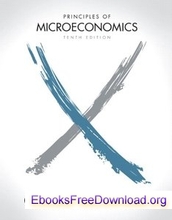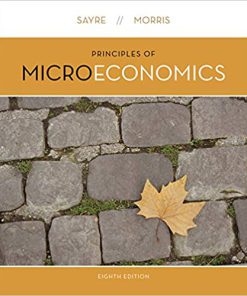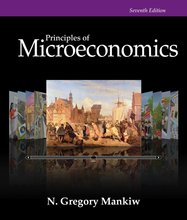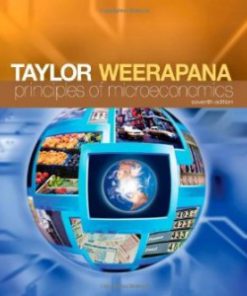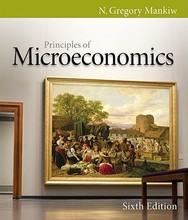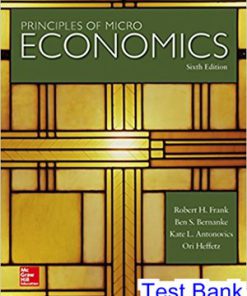Principles of Microeconomics 12th Edition Case Test Bank
$35.00 Original price was: $35.00.$26.50Current price is: $26.50.
Principles of Microeconomics 12th Edition Case Test Bank
This is completed downloadable of Principles of Microeconomics 12th Edition Case Test Bank
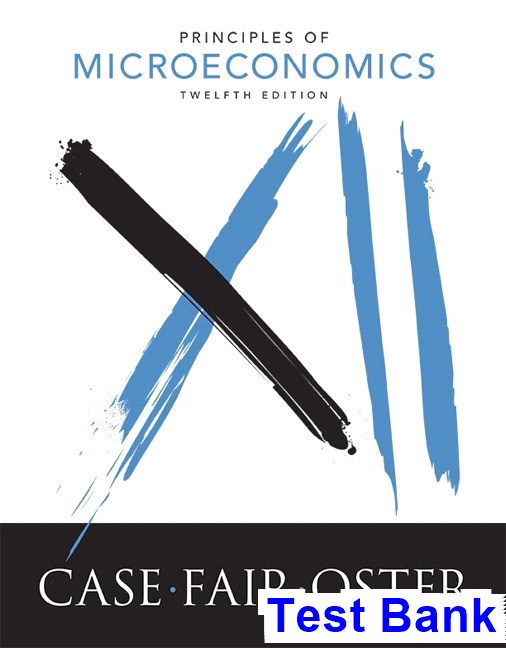
Product Details:
- ISBN-10 : 0134069609
- ISBN-13 : 978-0134069609
- Author: Karl Case (Author), Ray Fair (Author), Sharon Oster (Author)
For the one-semester course in Principles of Microeconomics. An Introduction to the Functioning of the Economy and the Power and Breadth of Economics Reviewers tell us that Case/Fair/Oster is one of the all-time bestselling Principles of Economics texts because they trust it to be clear, thorough, and complete. Readers of Principles of Microeconomics, Twelfth Edition come away with a basic understanding of how market economies function, an appreciation for the things they do well, and a sense of things they do poorly. With the latest research and added exercises, readers begin to learn the art and science of economic thinking and start to look at some policy and even personal decisions in a different way. Also Available with MyEconLab® This title is available with MyEconLab–an online homework, tutorial, and assessment program designed to work with this text to engage students and improve results. Within its structured environment, students practice what they learn, test their understanding, and pursue a personalized study plan that helps them better absorb course material and understand difficult concepts.
Table of Content:
- Part I Introduction to Economics
- 1 The Scope and Method of Economics
- Chapter Outline and Learning Objectives
- Why Study Economics?
- To Learn a Way of Thinking
- Opportunity Cost
- Marginalism
- Efficient Markets—No Free Lunch
- To Understand Society
- To Be an Informed Citizen
- The Scope of Economics
- Microeconomics and Macroeconomics
- The Diverse Fields of Economics
- The Method of Economics
- Theories and Models
- All Else Equal
- Expressing Models in Words, Graphs, and Equations
- Cautions and Pitfalls
- What Is Really Causal?
- Testing Theories and Models: Empirical Economics
- Economic Policy
- Efficiency
- Equity
- Growth
- Stability
- An Invitation
- Summary
- 1.1 Why Study Economics?
- 1.2 The Scope of Economics
- 3 The Method of Economics
- Review Terms and Concepts
- Problems
- 1.1 Why Study Economics
- Learning Objective:
- 1.2 The Scope of Economics
- Learning Objective:
- 1.3 The Method of Economics
- Learning Objective:
- Chapter 1 Appendix: How to Read and Understand Graphs
- Time Series Graphs
- Graphing Two Variables
- Plotting Income and Consumption Data for Households
- Slope
- Some Precautions
- Appendix Summary
- Appendix Review Terms And Concepts
- Appendix Problems
- CHAPTER 1 APPENDIX : How to Read and Understand Graphs
- Learning Objective:
- 2 The Economic Problem: Scarcity and Choice
- Chapter Outline and Learning Objectives
- Scarcity, Choice, and Opportunity Cost
- Scarcity and Choice in a One-Person Economy
- Opportunity Cost
- Scarcity and Choice in an Economy of Two or More
- Specialization, Exchange, and Comparative Advantage
- A Graphical Presentation of the Production Possibilities and Gains from Specialization
- Weighing Present and Expected Future Costs and Benefits
- Capital Goods and Consumer Goods
- The Production Possibility Frontier
- Negative Slope and Opportunity Cost
- The Law of Increasing Opportunity Cost
- Unemployment
- Inefficiency
- The Efficient Mix of Output
- Economic Growth
- Sources of Growth and the Dilemma of Poor Countries
- The Economic Problem
- Economic Systems and the Role of Government
- Command Economies
- Laissez-Faire Economies: The Free Market
- Consumer Sovereignty
- Individual Production Decisions: Free Enterprise
- Distribution of Output
- Price Theory
- Mixed Systems, Markets, and Governments
- Looking Ahead
- Summary
- 2.1 Scarcity, Choice, and Opportunity Cost
- 2.2 Economic Systems and The Role of Government
- Review Terms and Concepts
- Problems
- 2.1 Scarcity, Choice, and Opportunity Cost
- Learning Objective:
- 2.2 Economic Systems and the Role of Government
- Learning Objective:
- 3 Demand, Supply, and Market Equilibrium
- Chapter Outline and Learning Objectives
- Firms and Households: The Basic Decision-Making Units
- Input Markets and Output Markets: The Circular Flow
- Demand in Product/Output Markets
- Changes in Quantity Demanded versus Changes in Demand
- Price and Quantity Demanded: The Law of Demand
- Demand Curves Slope Downward
- Other Properties of Demand Curves
- Other Determinants of Household Demand
- Income and Wealth
- Prices of Other Goods and Services
- Tastes and Preferences
- Expectations
- Shift of Demand versus Movement along a Demand Curve
- From Household Demand to Market Demand
- Supply in Product/Output Markets
- Price and Quantity Supplied: The Law of Supply
- Other Determinants of Supply
- The Cost of Production
- The Prices of Related Products
- Shift of Supply versus Movement along a Supply Curve
- From Individual Supply to Market Supply
- Market Equilibrium
- Excess Demand
- Excess Supply
- Changes in Equilibrium
- Demand and Supply in Product Markets: A Review
- Looking Ahead: Markets and the Allocation of Resources
- Summary
- 3.1 Firms and Households: The Basic Decision-Making Units
- 3.2 Input Markets and Output Markets: The Circular Flow
- 3.3 Demand in Product/Output Markets
- 3.4 Supply in Product/Output Markets
- 3.5 Market Equilibrium
- Review Terms and Concepts
- Problems
- 3.1 Firms and Households: The Basic Decision-Making Units
- Learning Objective:
- 3.2 Input Markets and Output Markets: The Circular Flow
- Learning Objective:
- 3.3 Demand in Product/ Output Markets
- Learning Objective:
- 3.4 Supply in Product/Output Markets
- Learning Objective:
- 3.5 Market Equilibrium
- Learning Objective:
- 4 Demand and Supply Applications
- Chapter Outline and Learning Objectives
- The Price System: Rationing and Allocating Resources
- Price Rationing
- Constraints on the Market and Alternative Rationing Mechanisms
- Oil, Gasoline, and OPEC
- Rationing Mechanisms for Concert and Sports Tickets
- Prices and the Allocation of Resources
- Price Floor
- Supply and Demand Analysis: An Oil Import Fee
- Supply and Demand and Market Efficiency
- Consumer Surplus
- Producer Surplus
- Competitive Markets Maximize the Sum of Producer and Consumer Surplus
- Potential Causes of Deadweight Loss From Under- and Overproduction
- Looking Ahead
- Summary
- 4.1 The Price System: Rationing And Allocating Resources
- 4.2 Supply and Demand Analysis: An Oil Import Fee
- 4.3 Supply and Demand and Market Efficiency
- Review Terms and Concepts
- Problems
- 4.1 The Price System: Rationing and Allocating Resources
- Learning Objective:
- 4.2 Supply and Demand Analysis: An Oil Import Fee
- Learning Objective:
- 4.3 Supply and Demand and Market Efficiency
- Learning Objective:
- 5 Elasticity
- Chapter Outline and Learning Objectives
- Price Elasticity of Demand
- Slope and Elasticity
- Types of Elasticity
- Calculating Elasticities
- Calculating Percentage Changes
- Elasticity Is a Ratio of Percentages
- The Midpoint Formula
- Point Elasticity
- Elasticity Changes along a Straight-Line Demand Curve
- Elasticity and Total Revenue
- The Determinants of Demand Elasticity
- Availability of Substitutes
- The Importance of Being Unimportant
- Luxuries versus Necessities
- The Time Dimension
- Other Important Elasticities
- Income Elasticity of Demand
- Cross-Price Elasticity of Demand
- Elasticity of Supply
- What Happens When We Raise Taxes: Using Elasticity
- Looking Ahead
- Summary
- 5.1 Price Elasticity of Demand
- 5.2 Calculating Elasticities
- 5.3 The Determinants of Demand Elasticity
- 5.4 Other Important Elasticities
- 5.5 What Happens When We Raise Taxes: Using Elasticity
- Review Terms and Concepts
- Problems
- 5.1 Price Elasticity of Demand
- Learning Objective:
- 5.2 Calculating Elasticities
- Learning Objective:
- 5.3 The Determinants of Demand Elasticity
- Learning Objective:
- 5.4 Other Important Elasticities
- Learning Objective:
- 5.5 What Happens When We Raise Taxes: Using Elasticity
- Learning Objective:
- Part II The Market System
- 6 Household Behavior and Consumer Choice
- Chapter Outline and Learning Objectives
- Household Choice in Output Markets
- The Determinants of Household Demand
- The Budget Constraint
- Preferences, Tastes, Trade-Offs, and Opportunity Cost
- The Budget Constraint More Formally
- The Equation of the Budget Constraint
- Budget Constraints Change When Prices Rise or Fall
- The Basis of Choice: Utility
- Diminishing Marginal Utility
- Allocating Income to Maximize Utility
- The Utility-Maximizing Rule
- Diminishing Marginal Utility and Downward-Sloping Demand
- Income and Substitution Effects
- The Income Effect
- The Substitution Effect
- Household Choice in Input Markets
- The Labor Supply Decision
- The Price of Leisure
- Income and Substitution Effects of a Wage Change
- Saving and Borrowing: Present versus Future Consumption
- A Review : Households in Output and Input Markets
- Summary
- 6.1 Household Choice In Output Markets
- 6.2 The Basis of Choice: Utility
- 6.3 Income and Substitution Effects
- 6.4 Household Choice In Input Markets
- Review Terms and Concepts
- Problems
- 6.1 Household Choice in Output Markets
- Learning Objective:
- 6.2 The Basis of Choice: Utility
- Learning Objective:
- 6.3 Income and Substitution Effects
- Learning Objective:
- 6.4 Household Choice in Input Markets
- Learning Objective:
- Chapter 6 Appendix: Indifference Curves
- Learning Objective
- Assumptions
- Deriving Indifference Curves
- Properties of Indifference Curves
- Consumer Choice
- Deriving a Demand Curve from Indifference Curves and Budget Constraints
- Appendix Summary
- Appendix Review Terms and Concepts
- Appendix Problems
- Appendix 6A: Indifference Curves
- Learning Objective:
- 7 The Production Process: The Behavior of Profit-Maximizing Firms
- Chapter Outline and Learning Objectives
- The Behavior of Profit-Maximizing Firms
- Profits and Economic Costs
- Normal Rate of Return
- Short-Run versus Long-Run Decisions
- The Bases of Decisions: Market Price of Outputs, Available Technology, and Input Prices
- The Production Process
- Production Functions: Total Product, Marginal Product, and Average Product
- Marginal Product and the Law of Diminishing Returns
- Marginal Product versus Average Product
- Production Functions with Two Variable Factors of Production
- Choice of Technology
- Looking Ahead: Cost and Supply
- Summary
- 7.1 The Behavior of Profit-Maximizing Firms
- 7.2 The Production Process
- 7.3 Choice of Technology
- Review Terms and Concepts
- Problems
- 7.1 The Behavior of Profit-Maximizing Firms
- Learning Objective:
- 7.2 The Production Process
- Learning Objective:
- 7.3 Choice of Technology
- Learning Objective:
- Chapter 7 Appendix: Isoquants and Isocosts
- Learning Objective
- New Look at Technology: Isoquants
- Factor Prices and Input Combinations: Isocosts
- MyEconLab
- Finding the Least-Cost Technology with Isoquants and Isocosts
- The Cost-Minimizing Equilibrium Condition
- Appendix Summary
- Appendix Review Terms and Concepts
- Appendix Problems
- Appendix 7A: Isoquants and Isocosts
- 8 Short-Run Costs and Output Decisions
- Chapter Outline and Learning Objectives
- Costs in the Short Run
- Fixed Costs
- Total Fixed Cost (TFC)
- Average Fixed Cost (AFC)
- Variable Costs
- Total Variable Cost (TVC)
- Marginal Cost (MC)
- The Shape of the Marginal Cost Curve in the Short Run
- Graphing Total Variable Costs and Marginal Costs
- Average Variable Cost (AVC)
- Graphing Average Variable Costs and Marginal Costs
- Total Costs
- Average Total Cost (ATC)
- The Relationship between Average Total Cost and Marginal Cost
- Short-Run Costs: A Review
- Output Decisions: Revenues, Costs, and Profit Maximization
- Perfect Competition
- Total Revenue and Marginal Revenue
- Comparing Costs and Revenues to Maximize Profit
- The Profit-Maximizing Level of Output
- A Numerical Example
- The Short-Run Supply Curve
- Looking Ahead
- Summary
- 8.1 Costs In The Short Run
- 8.2 Output Decisions: Revenues, Costs, and Profit Maximization
- Review Terms and Concepts
- Problems
- 8.1 Costs in the Short Run
- Learning Objective:
- 8.2 Output Decisions: Revenues, Costs, and Profit Maximization
- 9 Long-Run Costs and Output Decisions
- Short-Run Conditions and Long-Run Directions
- Maximizing Profits
- Example: The Blue Velvet Car Wash
- Graphic Presentation
- Minimizing Losses
- Producing at a Loss to Offset Fixed Costs
- The Short-Run Industry Supply Curve
- Long-Run Directions: A Review
- Long-Run Costs: Economies and Diseconomies of Scale
- 9.2 Learning Objective
- Increasing Returns to Scale
- The Sources of Economies of Scale
- Constant Returns to Scale
- Diseconomies of Scale
- U-Shaped Long-Run Average Costs
- Long-Run Adjustments to Short-Run Conditions
- Short-Run Profits: Moves In and Out of Equilibrium
- The Long-Run Adjustment Mechanism: Investment Flows Toward Profit Opportunities
- Output Markets: A Final Word
- Summary
- 9.1 Short-Run Conditions and Long-Run Directions
- 9.2 Long-Run Costs: Economies and Diseconomies of Scale
- 9.3 Long-Run Adjustments to Short-Run Conditions
- Review Terms and Concepts
- Problems
- 9.1 Short-Run Conditions and Long-Run Directions
- Learning Objective:
- 9.2 Long-Run Costs: Economies and Diseconomies of Scale
- Learning Objective:
- 9.3 Long-Run Adjustments to Short-Run Conditions
- Learning Objective:
- Chapter 9 Appendix
- External Economies and Diseconomies
- Learning Objective
- The Long-Run Industry Supply Curve
- Appendix Summary
- External Economies And Diseconomies p. 204
- The Long-Run Industry Supply Curve p. 205
- Appendix Review Terms and Concepts
- Appendix Problems
- Appendix 9A: External Economies and Diseconomies and the Long-Run Industry Supply Curve
- Learning Objective:
- 10 Input Demand: The Labor and Land Markets
- Chapter Outline and Learning Objectives
- Input Markets: Basic Concepts
- Demand for Inputs: A Derived Demand
- Marginal Revenue Product
- Labor Supply
- Labor Markets
- The Firm’s Labor Market Decision
- Comparing Marginal Revenue and Marginal Cost to Maximize Profits
- Many Labor Markets
- Land Markets
- Rent and the Value of Output Produced on Land
- Input Demand Curves
- Shifts in Factor Demand Curves
- The Demand for Outputs
- The Quantity of Complementary and Substitutable Inputs
- The Prices of Other Inputs
- Technological Change
- Profit-Maximizing Condition in Input Markets
- Looking Ahead
- Summary
- 10.1 Input Markets: Basic Concepts
- 10.2 Labor Markets
- 10.3 Land Markets
- 10.4 Input Demand Curves
- 10.5 The Firm’s Profit-Maximizing Condition In Input Markets
- Review Terms and Concepts
- Problems
- 10.1 Input Markets: Basic Concepts
- Learning Objective:
- 10.2 Labor Markets
- Learning Objective:
- 10.3 Land Markets
- Learning Objective:
- 10.4 Input Demand Curves
- Learning Objective:
- 10.5 The Firm’s Profit-Maximizing Condition in Input Markets
- Learning Objective:
- 11 Input Demand: The Capital Market and the Investment Decision
- Chapter Outline and Learning Objectives
- Capital, Investment, and Depreciation
- Capital
- Tangible Capital
- Social Capital: Infrastructure
- Intangible Capital
- Measuring Capital
- Investment and Depreciation
- The Capital Market
- Capital Income: Interest and Profits
- Interest
- Profits
- Functions of Interest and Profit
- Financial Markets in Action
- Case A: Business Loans
- Case B: Venture Capital
- Case C: Retained Earnings
- Case D: The Stock Market
- Mortgages and the Mortgage Market
- Capital Accumulation and Allocation
- The Demand for New Capital and the Investment Decision
- Forming Expectations
- The Expected Benefits of Investments
- The Expected Costs of Investments
- Comparing Costs and Expected Return
- The Expected Rate of Return and the Marginal Revenue Product of Capital
- A Final Word on Capital
- Summary
- 11.1 Capital, Investment, and Depreciation
- 11.2 The Capital Market
- 11. 3 The Demand For New Capital and The Investment Decision
- Review Terms and Concepts
- Problems
- 11.1 Capital, Investment, and Depreciation
- Learning Objective:
- 11.2 The Capital Market
- Learning Objective:
- 11.3 The Demand for New Capital and the Investment Decision
- Learning Objective:
- 12 General Equilibrium and the Efficiency of Perfect Competition
- Chapter Outline and Learning Objectives
- Market Adjustment to Changes in Demand
- Allocative Efficiency and Competitive Equilibrium
- Pareto Efficiency
- Example: Budget Cuts in Massachusetts
- The Efficiency of Perfect Competition
- Efficient Allocation of Resources Among Firms
- Efficient Distribution of Outputs Among Households
- Producing What People Want: The Efficient Mix of Output
- Perfect Competition versus Real Markets
- The Sources of Market Failure
- Imperfect Competition
- Public Goods
- Externalities
- Imperfect Information
- Evaluating the Market Mechanism
- Summary
- 12.1 Market Adjustment To Changes In Demand
- 12.2 Allocative Efficiency and Competitive Equilibrium
- 12.3 The Sources of Market Failure
- 12.4 Evaluating The Market Mechanism
- Review Terms and Concepts
- Problems
- 12.1 Market Adjustments to Changes in Demand
- Learning Objective:
- 12.2 Allocative Efficiency and Competitive Equilibrium
- Learning Objective:
- 12.3 The Sources of Market Failure
- Learning Objective:
- Part III Market Imperfections and the Role of Government
- 13 Monopoly and Antitrust Policy
- Chapter Outline and Learning Objectives
- Imperfect Competition and Market Power: Core Concepts
- Forms of Imperfect Competition and Market Boundaries
- Price and Output Decisions in Pure Monopoly Markets
- Demand in Monopoly Markets
- Marginal Revenue and Market Demand
- The Monopolist’s Profit-Maximizing Price and Output
- The Absence of a Supply Curve in Monopoly
- Perfect Competition and Monopoly Compared
- Monopoly in the Long Run: Barriers to Entry
- Economies of Scale
- Patents
- Government Rules
- Ownership of a Scarce Factor of Production
- Network Effects
- The Social Costs of Monopoly
- Inefficiency and Consumer Loss
- Rent-Seeking Behavior
- Price Discrimination
- Examples of Price Discrimination
- Remedies for Monopoly: Antitrust Policy
- Major Antitrust Legislation
- The Sherman Act of 1890
- The Clayton Act and the Federal Trade Commission, 1914
- Imperfect Markets: A Review and a Look Ahead
- Summary
- 13.1 Imperfect Competition and Market Power: Core Concepts
- 13.2 Price and Output Decisions in Pure Monopoly Markets
- 13.3 The Social Costs of Monopoly
- 13.4 Price Discrimination
- 13.5 Remedies for Monopoly: Antitrust Policy
- Review Terms and Concepts
- Problems
- 13.1 Imperfect Competition and Market Power: Core Concepts
- Learning Objective:
- 13.2 Price and Output Decisions in Pure Monopoly Markets
- Learning Objective:
- 13.3 The Social Costs of Monopoly
- Learning Objective:
- 13.4 Price Discrimination
- Learning Objective:
- 13.5 Remedies for Monopoly: Antitrust Policy
- Learning Objective:
- 14 Oligopoly
- Chapter Outline and Learning Objectives
- Market Structure in an Oligopoly
- Oligopoly Models
- Learning Objective
- The Collusion Model
- The Price-Leadership Model
- The Cournot Model
- Game Theory
- Learning Objective
- Repeated Games
- A Game with Many Players: Collective Action Can Be Blocked by a Prisoner’s Dilemma
- Oligopoly and Economic Performance
- 4 Learning Objective
- Industrial Concentration and Technological Change
- The Role of Government
- 5 Learning Objective
- Regulation of Mergers
- A Proper Role for Government?
- Summary
- 14.1 Market Structure in an Oligopoly
- 14.2 Oligopoly Models
- 14.3 Game Theory
- 14.4 Oligopoly and Economic Performance
- 14.5 The Role of Government
- Review Terms and Concepts
- Problems
- 14.1 Market Structure in an Oligopoly
- Learning Objective:
- 14.2 Oligopoly Models
- Learning Objective:
- 14.3 Game Theory
- Learning Objective:
- 14.4 Oligopoly and Economic Performance
- Learning Objective:
- 14.5 The Role of Government
- Learning Objective:
- 15 Monopolistic Competition
- Chapter Outline and Learning Objectives
- Industry Characteristics
- Product Differentiation and Advertising
- How Many Varieties?
- How Do Firms Differentiate Products?
- Advertising
- The Case for Advertising
- The Case against Product Differentiation and Advertising
- Open Questions
- Price and Output Determination in Monopolistic Competition
- Product Differentiation and Demand Elasticity
- Price/Output Determination in the Short Run
- Price/Output Determination in the Long Run
- Economic Efficiency and Resource Allocation
- Summary
- 15.1 Industry Characteristics
- 15.2 Product Differentiation and Advertising
- 15.3 Price and Output Determination in Monopolistic Competition
- 15.4 Economic Efficiency and Rescource Allocation
- Review Terms and Concepts
- Problems
- 15.1 Industry Characteristics
- Learning Objective:
- 15.2 Product Differentiation and Advertising
- Learning Objective:
- 15.3 Price and Output Determination in Monopolistic Competition
- Learning Objective:
- 15.4 Economic Efficiency and Resource Allocation
- Learning Objective:
- 16 Externalities, Public Goods, and Common Resources
- Chapter Outline and Learning Objectives
- Externalities and Environmental Economics
- Marginal Social Cost and Marginal Cost Pricing
- Acid Rain and the Clean Air Act
- Other Externalities
- Some Examples of Positive Externalities
- Costs and Benefits of Pollution
- Internalizing Externalities
- Private Bargaining and Negotiation
- Environmental Standards
- Taxes and Subsidies
- Measuring Social Costs
- Subsidizing External Benefits
- Tradeable Emissions Permits: Selling or Auctioning Pollution Rights
- Public (Social) Goods
- The Characteristics of Public Goods
- Public Provision of Public Goods
- Optimal Provision of Public Goods
- The Samuelson–Musgrave Theory
- The Problems of Optimal Provision
- Local Provision of Public Goods: Tiebout Hypothesis
- Common Resources
- Summary
- 16.1 Externalities and Environmental Economics
- 16.2 Public (Social) Goods
- 16.3 Common Resources
- Review Terms and Concepts
- Problems
- 16.1 Externalities and Environmental Economics
- Learning Objective:
- 16.2 Public (Social) Goods
- Learning Objective:
- 16.3 Common Resources
- Learning Objective:
- 17 Uncertainty and Asymmetric Information
- Chapter Outline and Learning Objectives
- Decision Making Under Uncertainty: The Tools
- Expected Value
- Expected Utility
- Attitudes Toward Risk
- Asymmetric Information
- Adverse Selection
- Adverse Selection and Lemons
- Adverse Selection and Insurance
- Reducing Adverse Selection Problems
- Market Signaling
- Moral Hazard
- Incentives
- Labor Market Incentives
- Summary
- 17.1 Decision Making Under Uncertainty: The Tools
- 17.2 Asymmetric Information
- 17.3 Incentives
- Review Terms and Concepts
- Problems
- 17.1 Decision Making Under Uncertainty: The Tools
- Learning Objective:
- 17.2 Asymmetric Information
- Learning Objective:
- 17.3 Incentives
- Learning Objective:
- 18 Income Distribution and Poverty
- Chapter Outline and Learning Objectives
- The Sources of Household Income
- Wages and Salaries
- Income from Property
- Income from the Government: Transfer Payments
- The Distribution of Market Income
- Income Inequality in the United States
- Changes in the Distribution of Income
- The Lorenz Curve and the Gini Coefficient
- Causes of Inequality in Market Income
- Inequality in Wage Income
- Required Skills and Human Capital
- Compensating Differentials
- Discrimination
- Household Composition
- Inequality in Property Income
- Arguments for and Against Reducing Market-Income Inequality
- Arguments Against Redistribution
- Arguments in Favor of Redistribution
- Social Obligations
- Utilitarian Justice
- Social Contract Theory—Rawlsian Justice
- Redistribution of Income Through Taxes and Transfers
- The Tax System
- Income Taxes
- The Earned Income Tax Credit (EITC)
- The Transfer System
- Social Security
- Temporary Assistance to Needy Families (TANF)
- Unemployment Compensation
- Health Care: Medicaid and Medicare
- Supplemental Nutrition Assistance Program (SNAP)
- Housing Programs
- Redistribution Effects of Taxes and Transfers in 2011
- Change in U.S. Inequality Over Time: 1979–2011
- Poverty
- The Minimum Wage
- The Distribution of Wealth
- Income Inequality in Other Countries
- Government or the Market? A Review
- Summary
- 18.1 The Sources of Household Income
- 18.2 The Distribution of MARKET Income
- 18.3 Causes of Inequality In Market Income
- 18.4 Arguments for and Against Reducing Market-Income Inequality
- 18.5 Redistribution of Income Through Taxes and Transfers
- 18.6 Poverty
- 18.7 The Minimum Wage
- 18.8 The Distribution of Wealth
- 18.9 Income Inequality in Other Countries
- Review Terms and Concepts
- Problems
- 18.1 The Sources of Household Income
- Learning Objective:
- 18.2 The Distribution of Market Income
- Learning Objective:
- 18.3 Causes of Inequality in Market Income
- Learning Objective:
- 18.4 Arguments For and Against Reducing Market-Income Inequality
- Learning Objective:
- 18.5 Redistribution of Income Through Taxes and Transfers
- Learning Objective:
- 18.6 Poverty
- Learning Objective:
- 18.7 The Minimum Wage
- Learning Objective:
- 18.8 The Distribution of Wealth
- Learning Objective:
- 18.9 Income Inequality in Other Countries
- Learning Objective:
- 19 Public Finance: The Economics of Taxation
- Chapter Outline and Learning Objectives
- The Basics of Taxation
- Taxes: Basic Concepts
- Taxes on Stocks versus Taxes on Flows
- Proportional, Progressive, and Regressive Taxes
- Marginal versus Average Tax Rates
- How Much Does a Deduction Save You in Taxes?
- Tax Incidence: Who Pays?
- The Incidence of Payroll Taxes
- Labor Supply and Labor Demand Curves in Perfect Competition: A Review
- Imposing a Payroll Tax: Who Pays?
- The Incidence of Corporate Profits Taxes
- The Burden of the Corporate Tax
- The Overall Incidence of Taxes in the United States: Empirical Evidence
- Excess Burdens and the Principle of Neutrality
- Measuring Excess Burdens
- Excess Burdens and the Degree of Distortion
- The Principle of Second Best
- Optimal Taxation
- Tax Equity
- What Is the “Best” Tax Base?
- Income versus Consumption as the Best Tax Base
- Wealth as the Best Tax Base
- No Simple Answer
- Social Choice
- The Voting Paradox
- Government Inefficiency: Theory of Public Choice
- Rent-Seeking Revisited
- Summary
- 19.1 The Basics of Taxation
- 19.2 Tax Incidence: Who Pays?
- 19.3 Excess Burdens and the Principle of Neutrality
- 19.4 The Principle of Second Best
- 19.5 Tax Equity
- 19.6 Social Choice
- Review Terms and Concepts
- Problems
- 19.1 The Basics of Taxation
- Learning Objective:
- 19.2 Tax Incidence: Who Pays?
- Learning Objective:
- 19.3 Excess Burdens and the Principle of Neutrality
- Learning Objective:
- 19.4 The Principle of Second Best
- Learning Objective:
- 19.5 Tax Equity
- Learning Objective:
- 19.6 Social Choice
- Learning Objective:
- Part IV The World Economy
- 20 International Trade, Comparative Advantage, and Protectionism
- Chapter Outline and Learning Objectives
- Trade Surpluses and Deficits
- The Economic Basis for Trade: Comparative Advantage
- Absolute Advantage versus Comparative Advantage
- Gains from Mutual Absolute Advantage
- Gains from Comparative Advantage
- Why Does Ricardo’s Plan Work?
- Terms of Trade
- Exchange Rates
- Trade and Exchange Rates in a Two-Country/Two-Good World
- Exchange Rates and Comparative Advantage
- The Sources of Comparative Advantage
- The Heckscher-Ohlin Theorem
- Other Explanations for Observed Trade Flows
- Trade Barriers: Tariffs, Export Subsidies, and Quotas
- U.S. Trade Policies, GATT, and the WTO
- Economic Integration
- Free Trade or Protection?
- The Case for Free Trade
- The Case for Protection
- Protection Saves Jobs
- Some Countries Engage in Unfair Trade Practices
- Cheap Foreign Labor Makes Competition Unfair
- Protection Safeguards National Security
- Protection Discourages Dependency
- Environmental Concerns
- Protection Safeguards Infant Industries
- An Economic Consensus
- Summary
- 20.1 Trade Surpluses and Deficits
- 20.2 The Economic Basis for Trade: Comparative Advantage
- 20.3 The Sources of Comparative Advantage
- 20.4 Trade Barriers: Tariffs, Export Subsidies, and Quotas
- 20.5 Free Trade or Protection?
- Review Terms and Concepts
- Problems
- 20.1 Trade Surpluses and Deficits
- Learning Objective:
- 20.2 The Economic Basis for Trade: Comparative Advantage
- Learning Objective:
- 20.3 The Sources of Comparative Advantage
- Learning Objective:
- 20.4 Trade Barriers: Tariffs, Export Subsidies, and Quotas
- Learning Objective:
- 20.5 Free Trade or Protection?
- Learning Objective:
- 21 Economic Growth in Developing Economies
- Chapter Outline and learning objectives
- Life in the Developing Nations: Population and Poverty
- Economic Development: Sources and Strategies
- The Sources of Economic Development
- Capital Formation
- Human Resources and Entrepreneurial Ability
- Infrastructure Capital
- Strategies for Economic Development
- The Role of Government
- The Movement from Agriculture to Industry
- Exports or Import Substitution?
- Microfinance
- Two Examples of Development: China and India
- Development Interventions
- Random and Natural Experiments: Some New Techniques in Economic Development
- Education Ideas
- Health Improvements
- Summary
- 21.1 Life in the Developing Nations: Population and Poverty
- 21.2 Economic Development: Sources and Strategies
- 21.3 Development Interventions
- Review Terms and Concepts
- Problems
- 21.1 Life in the Developing Nations: Population and Poverty
- Learning Objective:
- 21.2 Economic Development: Sources and Strategies
- Learning Objective:
- 21.3 Development Interventions
- Learning Objective:
- Part V Methodology
- 22 Critical Thinking about Research
- Chapter Outline and learning objectives
- Selection Bias
- Causality
- Correlation versus Causation
- Random Experiments
- Regression Discontinuity
- Difference-in-Differences
- Statistical Significance
- Regression Analysis
- Summary
- 22.1 Selection Bias
- 22.2 Causality
- 22.3 Statistical Significance
- 22.4 Regression Analysis
- Review Terms and Concepts
- Problems
- 22.1 Selection Bias
- Learning Objective:
- 22.2 Causality
- Learning Objective:
- 22.3 Statistical Significance
- Learning Objective:
- 22.4 Regression Analysis
- Learning Objective:
- Glossary
- Index
- A
- B
- C
- D
- E
- F
- G
- H
- I
- J
- K
- L
- M
- N
- O
- P
- Q
- R
- S
- T
- U
- V
- W
- X
- Y
- Z
- Photo Credits
People Also Search:
principles of microeconomics 12th edition case
principles of microeconomics 12th edition case test bank download pdf
principles of microeconomics 12th edition case download scribd




